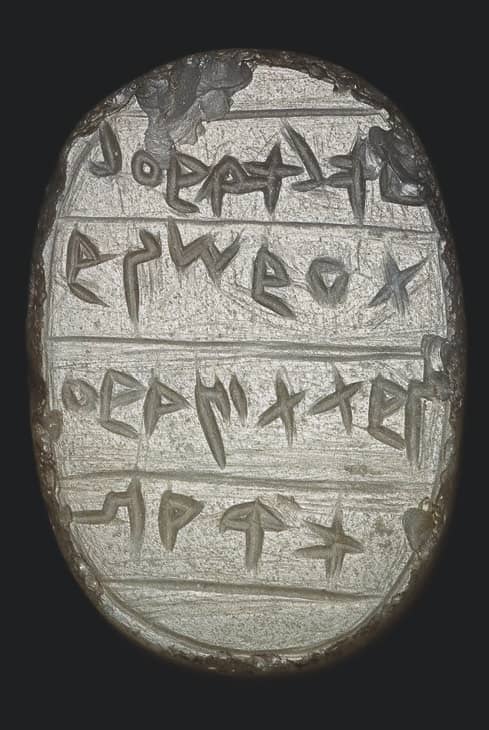Try GOLD - Free
Words Of Power & The Power Of Words
Minerva
|July/August 2019
Curator Peter Toth explores the crucial role that writing has played, plays, and will continue to play in human history – as shown in cuneiform, hieroglyphs, runes, letters and emojis inscribed across a fascinating exhibition on show at the British Library

‘The pen is mightier than the sword’, as the old saying goes, and it is true that those physically more threatening swords can be governed by pens (or even the humble pencil) and the words generated by them. It is not hard to realise the tremendous power of the written word if we think about wars and the way that they started. Students are taught that the four-year horror of the First World War began when Austria-Hungary declared war against Serbia on July 1914. This declaration was followed by a number of countries across Europe and resulted in one of the bloodiest and most devastating conflicts in human history – and the message that started it all, in 1914, was on one sheet of paper, a telegram sent from Vienna to Belgrade transcribed with pencil in a dozen or so lines, in French, concluding that: ‘From this moment on, Austria-Hungary considers itself in a state of war with Serbia.’
We all know that the war was about to break out. Its reasons and the fact that it had been imminent for a long time have been told, analyzed and discussed hundreds and hundreds of times – but it did not actually start until those 12 lines were telegraphed from Vienna to Belgrade. Those written words and the ‘pen’ behind them were needed to put the swords in action.

So, what is the formidable power that writing possesses, where does it come from, how did it come about and what is happening to it in the current digital age? These are some of the questions that lie behind the British Library’s current exhibition, Writing: Making Your Mark.
This story is from the July/August 2019 edition of Minerva.
Subscribe to Magzter GOLD to access thousands of curated premium stories, and 10,000+ magazines and newspapers.
Already a subscriber? Sign In
MORE STORIES FROM Minerva

Minerva
ROMAN DISCOVERIES AT ANCIENT AUGUSTODUNUM
More than 230 graves have been uncovered at a necropolis in the French city of Autun, revealing a diverse mix in burial practices over a period of nearly 200 years, as well as luxury grave goods from the 3rd and 4th centuries AD that highlight the wealth of some of its ancient inhabitants.
2 mins
January/February 2021

Minerva
SHAPING THE WORLD: SCULPTURE FROM PREHISTORY TO NOW
The sculptor Antony Gormley and the art historian and critic Martin Gayford have been talking about sculpture with each other for 20 years.
3 mins
January/February 2021

Minerva
Amelia Edwards (1831-1892)
“I am essentially a worker, and a hard worker, and this I have been since my early girlhood.”
2 mins
January/February 2021

Minerva
THE GREAT BEYOND
The ancient Greeks thought much about the dead – how their remains should be disposed of, how their spirits might be summoned, how malignant they could be if unavenged. Classicist David Stuttard brings us face to face with the Greek dead.
11 mins
January/February 2021

Minerva
INTO THE VALLEY OF THE QUEENS
The Great Royal Wife of Ramesses II, Nefertari, was buried in one of the most spectacular tombs of Egypt’s Valley of the Queens. Well-educated and well-travelled, Nefertari played a crucial part in the political life of the pharaoh, and her importance was reflected through her magnificently decorated tomb. Lucia Marchini speaks to Jennifer Casler Price to find out more.
10 mins
January/February 2021

Minerva
DEIR EL-BAHRI, 1894
Tensions were already high among the archaeologists, surveyors, and artists of the Archaeological Survey of Egypt in 1891 when an eventful dispute arose on Christmas Eve.
2 mins
January/February 2021

Minerva
PUSHING BOUNDARIES
When the Etruscans expanded to the south and the vast plains of Campania, they found a land of cultural connections and confrontations, as luxurious grave goods found across the region reveal. An exhibition at the National Archaeological Museum in Naples sheds light on these ancient Italians at the frontier. Paolo Giulierini, director of the museum, is our guide.
12 mins
January/February 2021

Minerva
CUZCO 'CENTRE AND HEAD OF ALL THE LAND'
Cuzco was the heart of the vast Inca empire, but all changed in the 16th century when the capital was conquered by Spanish invaders. Michael J Schreffler investigates the Inca city, and how it went from the centre of one empire to the periphery of another.
9 mins
January/February 2021

Minerva
A STUDY IN PURPLE
A tiny speck of purple paint from the 2nd century AD may yield clues to how ancient artists created the extraordinary portrait panels that accompanied mummified bodies into the afterlife.
3 mins
January/February 2021

Minerva
Rome In The 8th Century: A History In Art
John Osborne CAMBRIDGE UNIVERSITY PRESS, £75 HARDBACK - ISBN 978-1108834582
3 mins
November/December 2020
Translate
Change font size
